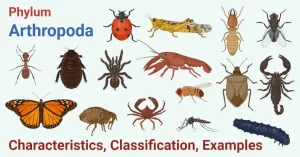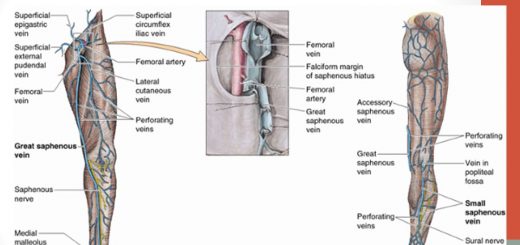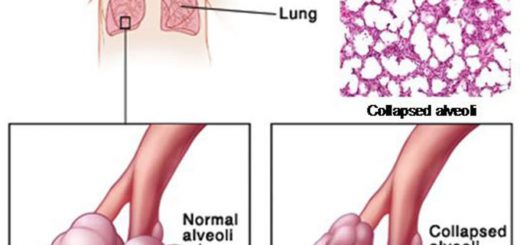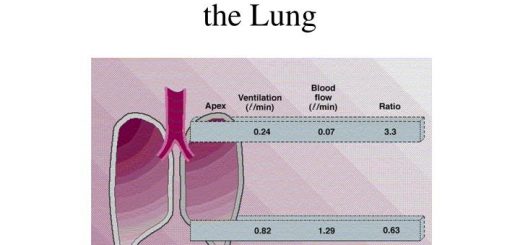Medical entomology, Arthropods types, Toxaemia, Scorpion sting, Mosquito dermatitis and scabies
Arthropods are highly organized invertebrate animals. They have a bilaterally symmetrical body and possess jointed appendages in the form of legs, mouth parts, antennae, and wings. They are covered externally with a chitinous exoskeleton which serves to the protection of the internal organs. In the body cavity of arthropods, the haemocoele is filled with a clear colourless fluid representing the blood called the haemolymph.
Arthropods
Arthropods are differentiated sexually into males and females. After fertilization, females deposit eggs or larvae. Two different types of development then take place namely:
- Incomplete Metamorphosis: The newly hatched larvae in this type of development resemble the adults but are smaller in size and sexually immature, Then they gradually increase in size by successive molting e.g. scorpion, ticks, mites, and lice.
- Complete Metamorphosis: The newly hatched larvae are totally different morphologically from the adults. They may be worm-like, and they transform into the inactive pupal stage from which the adults emerge e.g, fleas, flies, and mosquitoes.
Classification of Arthropods
Arthropods of medical importance are included in the following classes:
- Class Crustacea e.g. cyclops.
- Class Arachnida e.g. scorpions, spiders, ticks, and mites.
- Class Insecta or Hexapoda e.g. fleas, lice, bugs, mosquitoes, and flies.
Criteria of arthropods
Arthropods:
- Crustacea: Fused cephalothorax and segmented abdomen, 5 pairs of legs, 2 pairs of antenna, No wings. Ex: Cyclops.
- Arachnida: Either used, cephalothorax and segmented abdomen or fused unsegmented body, 4 pairs of legs, No antenna, No wings. Ex: Ticks, Mites and Scorpion, Spiders.
- Insecta (Hexapoda): The body is segmented into a head thorax and abdomen, 3 pairs of legs, 1 pair antenna, Winged or not. Ex: Mosquitoes, Files, Fleas Lice, and Bugs.
Medical Importance of Arthropods
Arthropods are agents transmitting and /or causing diseases to man.
Arthropods as Vectors of Pathogens (Disease Transmitters)
They may act either as mechanical vectors of the etiologic agent or as biological vectors taking an essential role in the life cycle.
1. Mechanical Transmission
When the arthropods transport the various pathogens in or on their bodies (their legs, hairs, and antennae) and drop them unchanged on human food, drink or tissues e.g. the role of house flies in the transmission of enteric pathogens as polio virus and cholera cysts of protozoa and egg of helminths.
2. Biological Transmission
This type of transmission occurs when the arthropod takes an active role in the transmission of the organism, This type of transmission can be divided into:
- Propagative: The organism simply multiplies in the arthropod without any cyclical development like in a culture tube, e.g., multiplication of Yersinia pestis (causing plague) in the fleas.
- Cyclodevelopmental: The organism undergoes developmental or morphological changes only without multiplication in the arthropod, e.g., development of microfilaria of filarial worms within the mosquitoes.
- Cyclopropagative: Organisms undergo both developmental changes and multiplication in the arthropod, e.g. Plasmodia in the female Anopheles mosquito and Leishmania species in the sand fly.
Arthropods can convey the organisms to man by different methods
- Vomit-drop: Non-blood-sucking flies may deposit a vomit drop containing the pathogens on human food or drink, e.g. cysts of Entamoeba histolytica, Other arthropod species may obtain the pathogenic organisms in a blood meal, from an infected person and deposit them in a vomit drop in the puncture wound made in the skin of an uninfected person, eg. Transmission of leishmaniasis by sandflies and plague by fleas.
- Faeces: Non-blood-sucking flies may deposit their faeces containing the pathogens on human food or drink e.g., (cysts of Entamoeba histolytica.
- Salivary Secretion: Pathogens are discharged in minute droplets with the salivary secretion at the time the arthropod is taking a blood meal. e.g. Plasmodia by female Anopheles mosquitoes.
- Crushing: Contamination from the infected haemolymph may occur when the arthropod is crushed on the skin.
- Coxal Fluid: During the act of feeding, soft ticks produce infective fluids from their coxal glands that contaminate the bite wound or skin.
II. Arthropods as Etiological Agents of Disease (Causing Disease)
In addition to their importance in the transmission of pathogens to man, arthropods themselves play a significant part as disease-producing agents.
- Toxins and Venoms introduced into the skin by the tick’s bite or scorpion’s sting, cause either local and/or systemic reactions.
- Allergic Reactions: These reactions may occur due to the injection of the saliva of blood-sucking arthropods into the skin of the host as dermatitis caused by female mosquitoes, and fleas in addition to lice causing pediculosis, Itch mite causes scabies in the skin of man, House dust mites may cause rhinitis or asthma by serving directly as allergens or by concentrating highly antigenic material.
- Specific Parasites produce lesions in humans through their presence in the tissues (the adult or any developmental stage), e.g., the presence of larvae of higher Diptera in the tissues causing myiasis.
- Entomophobia: Fear of arthropods can be extremely important as a cause of severe neurosis.
Examples of Diseases Caused by Arthropods
- Toxaemia caused by scorpion sting and tick bite.
- Allergic reactions in the skin and respiratory tract.
- Myiasis.
Toxaemia Caused by Arthropods
1. Scorpion sting
The stinger of a scorpion during stinging releases venom which contains toxins that affect the nervous system (neurotoxins), It produces an immediate intense aching pain, with a burning sensation radiating from the site of the sting and lymphadenitis, Systemic symptoms occur frequently including generalized numbness, throbbing, and twitching especially of fingers, toes, ear lobes, and the tip of the nose and chin.
Other symptoms include profuse sweating, excess salivation, glossopharyngeal involvement so that speech and swallowing become difficult, together with vomiting, muscle spasm of the abdomen, and convulsions, Mental disturbances, hallucinations, and ascending motor paralysis can also be observed. The patient may die by shock or respiratory failure.
Diagnosis
Diagnosis is made when the patient gives a history of being stung by a scorpion together with the typical clinical picture.
Treatment
1. Local: Ligate the limb with a tourniquet proximal to the site of the sting and incise over the sting until the blood washes the toxin, and cover the wound with a disinfectant such as potassium permanganate to oxidize the venom. Local pain is relieved by a local anaesthetic administered topically.
2. General:
- Maintenance of the airway, to assist respiration.
- Maintenance of blood pressure by intravenous infusion and hydrocortisone.
- Suitable oral or parenteral analgesic.
- General supportive treatment.
- Antivenin should be given intramuscularly.
Tick bite
Insertion of mouth parts of hard ticks in the skin layers with continuous feeding activity will lead to inflammatory cell infiltration, hyperemia, oedema and haemorrhage, The forcible removal of the lick causes additional damage, as the detached mouth parts remain in the tissues causing foreign body reactions (Tick dermatosis).
If the tick is present in the back of the neck or along the spinal cord, it will inject its neurotoxin with the saliva causing Tick Paralysis, The condition is characterized by generalized toxaemia with the rise in temperature and rapid ascending flaccid paralysis leading to difficulty in swallowing and breathing, which may be fatal, Without removal of the tick, the respiratory muscles will fail and the patient will die of respiratory failure and toxaemia, Heavy tick infestation can lead to blood loss and anaemia.
Treatment
A few drops of chloroform or ether placed on the tick will usually cause it to relax its hold and will allow it to be easily removed by traction using forceps.
Allergy Caused by Arthropods
Arthropods causing allergic dermatitis
- Mosquitoes.
- Fleas.
- Bugs.
- Lice.
- Itch mite (Sarcoptes scabiei).
Mosquito dermatitis
It is caused by a local allergic reaction against the salivary secretion of mosquitoes, This can proceed to severe allergic reactions in highly susceptible individuals.
Flea dermatitis
Fleas bites can cause discomfort and local allergic reactions, The lesion is reddish, oedematous, indurated or even pustular.
Bug dermatitis
Bed bugs crawl out at night to obtain a blood meal leading to annoyance and local dermatitis (allergy to saliva), Persistent feeding may cause anaemia.
Lice dermatitis
Infestation of the skin by body lice causes chronic irritation of the skin (pediculosis) by prolonged exposure to salivary secretions following frequent biting. The patient becomes hypersensitive, and the skin develops a peculiar form of dermatitis characterized by bronzed pigmentation and pustular formation. Years of infestation lead to darkened skin, a condition known as vagabond’s disease, On the other hand, in untreated cases of head lice, the hair becomes matted together from the exudate and fungus growth. The mass develops a foetid odour, this condition is known as plica polonica
Scabies
The disease is caused by Sarcoptes scabiei (itch mite). Overcrowding and poor hygiene are the known risk factors for the infestation, Fertilized females penetrate the horny layer of the skin and keep on burrowing in the epidermis, resulting in the formation of tunnels.
As they feed on the tissues, the mites deposit minute faecal pellets which are believed to provoke the characteristic lesions of the skin and severe pruritus (type I hypersensitivity reaction to the mites, their eggs, and their wastes). Pruritus is intensified by warmth and perspiration of the affected area. Thus, itching is mainly at night nocturnal itching. Furthermore, increased body warmth at night activates the mite to produce an acidic secretion which further intensifies the irritation.
Clinically, scabies present with polymorphic skin lesions in the form of an erythema, papules, nodules, vesicles, scratch marks, and crusts, Secondary bacterial infection and Pustule formation usually complicate the lesion. The usual sites infested are those where the skin is soft, thin, and moist webs of the inter-digital spaces, flexor aspect of the arm, elbows, axillae, groin, breast, umbilicus, shoulder, back, and buttocks.
Arthropods causing allergy through inhalation
Allergenic mites in house dust (Dermatophagoides farinae)
House dust mites are found in dust on the floors, furniture, mattresses, and bedding. These mites directly act as allergens (in their bodies, fragments and faeces). They may also concentrate on potent allergens commonly found in the house. Inhalation of these mites leads to allergic reactions in the form of rhinitis or asthma.
You can follow science online on YouTube from this link: Science online
You can download Science online application on Google Play from this link: Science online Apps on Google Play
Medical protozoology, Protozoa Features, Life Cycle of Sarcodina, Mastigophora & Apicomplexa
Medical helminthology, Flat & Round Worms, Life Cycle of Trematodes, Cestodes & Nematodes
Medical parasitology, Sources of Parasitic Infection, Types of Parasites & Hosts
Importance & types of fungi, Opportunistic infections & Predisposing factors to candidosis
Vaccines types, Live vaccines, Inactivated vaccines, Subunit vaccines, Naked DNA & mRNA vaccines
Features and classification of viruses, Defective viruses & Viral vectors used for gene therapy




